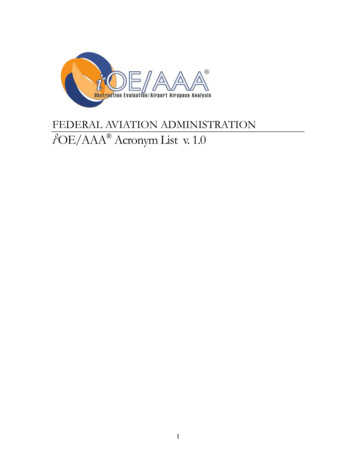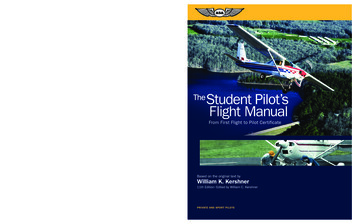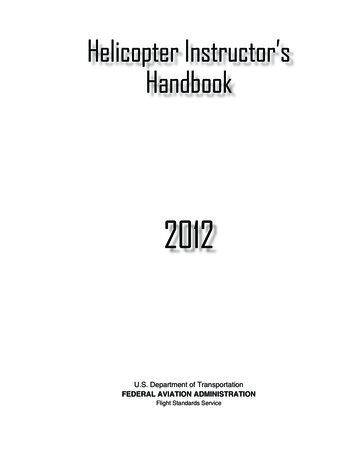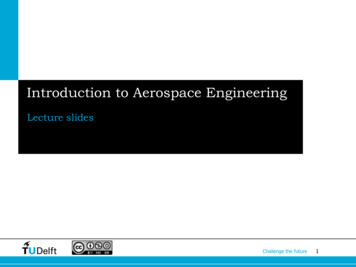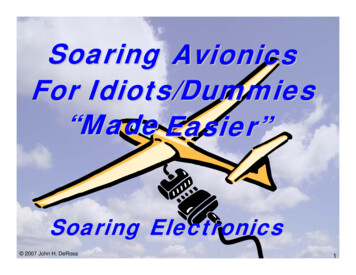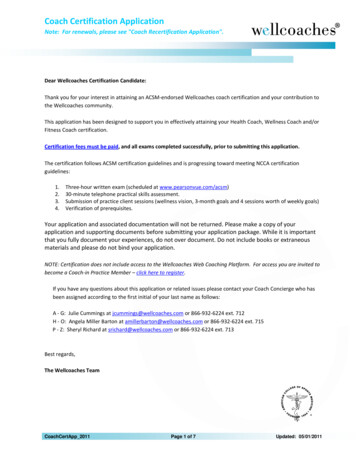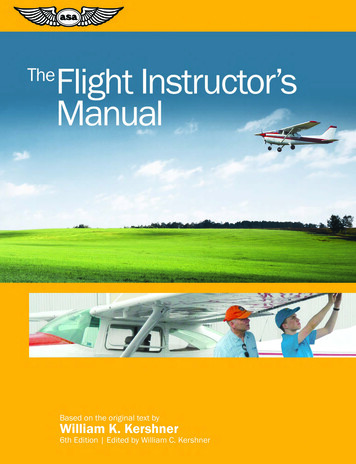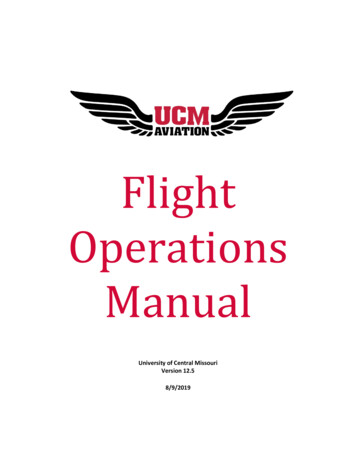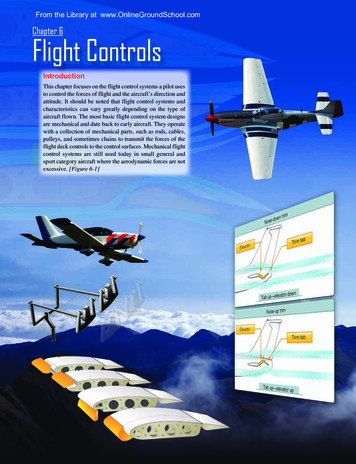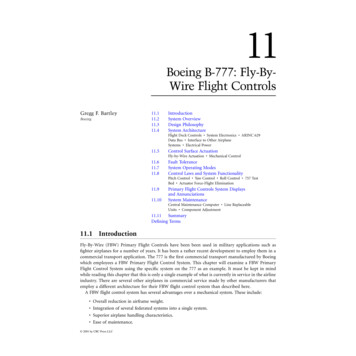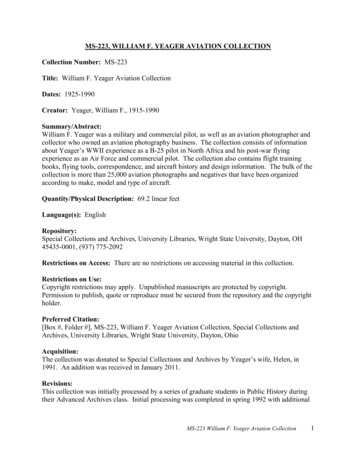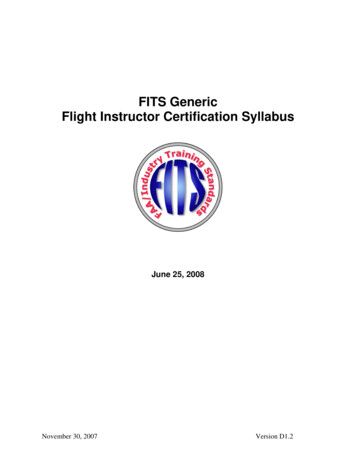
Transcription
FITS GenericFlight Instructor Certification SyllabusJune 25, 2008November 30, 2007Version D1.2
Table of ContentsSection 1 – IntroductionHow to use this Syllabus33RegulationsFITS Acceptance3Four Levels of FITS Acceptance4Section 2 – FITS Terminology5Section 3 – Training Philosophy7Section 4 – Teaching Methods9Scenario-Based Training (SBT)9Example of Scenario Based Training9Developing Scenario-Based Training11Single Pilot Resource Management (SRM)15The 5 P Check17The SRM Decision Process2121Example of Single Pilot Resource ManagementLearner Centered Grading (LCG)22Desired Outcomes25Example of Learner Centered Grading26Section 5 – FITS Flight Instructor Certification Syllabus2828To the Pilot-in-Training (PT) and InstructorUsing of Decision-Making scenarios in flight training28The Pilot-in-Training plays a role in grading the lesson29The format of each lesson30Syllabus Shuffle3031Flight Instructor Certification SyllabusFITS Flight Instructor Certification Curriculum Outline31Analyze the Performance Elements and Flight Characteristics of theAircraft3333Lesson 1 – Ground Lesson37Lesson 2 – Flight LessonLesson 3 – Ground Lesson4145Lesson 4 – Flight LessonLesson 5 – Ground Lesson49Lesson 6 – Flight Lesson52Lesson 7 – Ground Lesson55Lesson 8 – Flight Lesson58Lesson 9 – Ground Lesson6164Lesson 10 – Flight LessonLesson 11 – Ground Lesson67Lesson 12 – Flight Lesson730Lesson 13 – Ground Lesson7375Lesson 14 – Flight LessonNovember 30, 2007iVersion – D1.23
Lesson 15 – Ground LessonLesson 16 – Flight LessonLesson 17 – Flight LessonStrand 3-Applying the Teaching Process and Fundamentals ofInstruction through a Variety of Ground and Flight InstructionLesson 18 – Ground LessonLesson 19 – Ground LessonLesson 20 – Flight LessonLesson 21 – Ground LessonLesson 22 – Flight LessonLesson 23 – Ground LessonLesson 24 – Flight LessonLesson 25 – Ground LessonLesson 26 – Flight LessonLesson 27 – Ground LessonLesson 28 – Flight LessonLesson 29 – Ground LessonLesson 30 – Flight LessonLesson 31 – Ground LessonLesson 32 – Flight LessonLesson 33 – Ground LessonLesson 34 – Flight LessonLesson 35 – Progress CheckLesson 36 – Flight LessonLesson 37 – FAA Practical TestNovember 30, 2007iiVersion – 28131133136140143
SECTION 1 – INTRODUCTIONHow to use this SyllabusThis syllabus is the generic version of a FAA Industry Training Standards (FITS)accepted flight instructor training course. This generic syllabus is a guide for you to usein developing your specific FITS curriculum. This FITS Syllabus is intended as a guidefor aircraft manufacturers, training providers, and flight schools to use in developing aspecific FITS curriculum for their aircraft, geographic region, and customer base. Thissyllabus is unique in several ways. First, it is a syllabus that uses real-world scenariosas the foundation of the training. Flight maneuvers are still a vital part of flight trainingand flight maneuvers are a part of this syllabus, but the use of real-world scenarios isused to enhance development of pilot decision making skills. The syllabus presentssituations and circumstances that pilots face everyday as learning experiences andlessons. The primary tenant of FITS training is that you prepare for the real world offlying, by acting as an instructor while in training. Therefore, throughout the syllabus, thepilot in training (PT) will take on different tasks or jobs just as if they were alreadycertificated flight instructors. The second important unique feature of this syllabus and ofFITS training is that it is all competency based. When the pilot in training (PT) masters aparticular skill area in the syllabus, he/she moves on regardless of how much time ittakes to reach that point of mastery. This means that each lesson does not necessarilyequal one flight. It may take several flights before the PT masters the elements of thelesson and is ready to move on to the next lesson. Consequently, the amount of totalflight hours a PT has when the syllabus is completed may be more or less than theminimum times under current aviation regulations. Please note that FITS training isconducted under the current 14 CFR's. Although philosophically, FITS is competencybased, many training organizations must still require their students to meet the FAAminimum training hours. Courses under 14 CFR Parts 142 and 141.55(d) may beapproved to train to competency and not require a minimum number of hours.RegulationsThis generic syllabus is adaptable to 14 CFR Parts 142, 141, or 61. Please refer to theappropriate regulations for your specific curriculum requirements.FITS AcceptanceFITS acceptance is achieved by developing your specific curriculum and submitting it toyour local Flight Standards District Office for operations under 14 CFR Part 61, 141, and142. If you are an OEM (Original Equipment Manufacturer, you should submit yourcurriculum to the FAA FITS Program Manager, AFS-800, Federal AviationAdministration, 800 Independence Ave. SW, Washington, DC 20591. A cover letterexplaining exactly for what courses you are requesting FITS acceptance and underwhat regulations should accompany the curriculum. Use of the FITS logo: Onceaccepted, you are free to use the FITS Logo on all accepted curriculums and inNovember 30, 2007Version D1.2
advertising about this particular curriculum. The FITS logo cannot be used inrelationship to non-FITS products.The Four Levels of FITS Acceptance1. Accepted FITS Flight Syllabus: Will contain all the tenets of FITS and will includeflight in an aircraft or at least an Advanced Training Device. Examples of this type ofsyllabus include initial, transition, and recurrent training syllabi.2. Accepted FITS Syllabus (No flight): It is not intended to teach the pilot in training(PT) psychomotor pilot skills or full cockpit/aircraft integration in a specific aircraft.It’s intended to enhance certain skill sets of the PT. Application of this level ofacceptance may be to teach the PT how to use a new glass cockpit display ordevelop better Single Pilot Resource Management (SRM) skills. A FITS AcceptedSyllabus will also contain all the tenets of FITS. A live instructor will lead thetraining.3. Accepted FITS Self-Learning Program: This acceptance is between the FITSAccepted Syllabus and FITS Supporting Material. It may be either an interactive CDor on-line course on a specific application or subject. The purpose of this training isto learn a specific piece of equipment or enhance a specific higher order thinkingskill. Scenario training and/or testing is required. Since a live instructor is notrequired, Learner Centered Grading may not be applicable.a. If the program is for a piece of equipment (i.e. GPS), the equipment shouldact like the actual piece of equipment during the interaction with theequipment as much as feasible. After basic training on the equipment,scenarios should be used to demonstrate PT proficiency and knowledge.b. For non equipment programs (i.e. ADM development) scenarios with multistring testing should be used.4. Accepted FITS Supporting Material: These products do not meet the training tenetsof FITS (i.e. may not be scenario based), but the subject is integral to FITS. Theseproducts could be accepted on their own technical merit, but only as a part of anAccepted FITS Flight Syllabus or FITS Syllabus. For example, a CBI on riskmanagement could be accepted as and used as a module in a FITS acceptedtransition syllabus. Original equipment manufacturers (Cessna, Cirrus, Eclipse, etc.)or developers of training materials (Sporty’s, Jeppesen, King Schools, etc.) normallydevelop Accepted FITS Supporting Material.November 30, 20074Version – D1.2
SECTION 2 – FITS TERMINOLOGY1. Automation Bias – The relative willingness of the pilot to trust and utilizeautomated systems.2. Automation Competence – The demonstrated ability to understand and operatethe automated systems installed in the aircraft.3. Automation Management – The demonstrated ability to control and navigate anaircraft by means of the automated systems installed in the aircraft.4. Automated Navigation leg – A flight of 30 minutes or more conducted betweentwo airports in which the aircraft is controlled primarily by the autopilot and the onboard navigation systems.5. Automation Surprise – Occurs when the automation behaves in a manner that isdifferent from what the operator is expecting.6. Candidate Assessment – A system of critical thinking and skill evaluationsdesigned to assess a pilot in training’s readiness to begin training at the requiredlevel.7. Critical Safety Tasks/Events – Those mission related tasks/events that if notaccomplished quickly and accurately may result in damage to the aircraft or lossof life.8. Data link Situational Awareness Systems – Systems that feed real-timeinformation to the cockpit on weather, traffic, terrain, and flight planning. Thisinformation may be displayed on the PFD, MFD, or on other related cockpitdisplays.9. Emergency Escape Maneuver – A maneuver (or series of maneuvers) performedmanually or with the aid of the aircraft’s automated systems that will allow a pilotto successfully escape from an unanticipated flight into Instrument MeteorologicalConditions (IMC) or other life-threatening situations.10. IFR Automated Navigation Leg – A leg flown on autopilot beginning from 500 ftAGL on departure (unless the limitations of the autopilot require a higher altitude,then from that altitude) until reaching the decision altitude or missed approachpoint on the instrument approach (unless the limitations of the autopilot require ahigher altitude, then from that altitude). If a missed approach is flown, it will alsobe flown using the autopilot and on-board navigation systems.11. Light Turbine TAA –is a jet or turboprop Technically Advance Aircraft (TAA)certified for single-pilot operations, weighing 12,500 lbs or less, that may beNovember 30, 20075Version – D1.2
equipped with cabin pressurization, and may be capable of operating in Class Aairspace on normal mission profiles.12. Mission Related Tasks – Those tasks required for safe and effective operationswithin the aircraft’s certificated performance envelope.13. Multi-Function Display MFD – Any display that combines primarily navigation,systems, and situational awareness information onto a single electronic display.14. Primary Flight Display (PFD) – Any display that combines the primary six flightinstruments, plus other related navigation and situational awareness informationinto a single electronic display.15. Proficiency-Based Qualification – Aviation task qualification based ondemonstrated performance rather than other flight time or experience.16. Scenario Based Training – A training system that uses a highly structured scriptof real-world experiences to address flight-training objectives in an operationalenvironment. Such training can include initial training, transition training, upgradetraining, recurrent training, and special training. The appropriate term shouldappear with the term "Scenario Based," e.g., "Scenario Based TransitionTraining," to reflect the specific application.17. Simulation Training Only – Any use of animation and/or actual representations ofaircraft systems to simulate the flight environment. Pilot in training interactionwith the simulation and task fidelity for the task to be performed are required foreffective simulation.18. Single Pilot Resource Management (SRM) – The art and science of managing allresources (both on-board the aircraft and from outside sources) available to asingle pilot (prior and during flight) to ensure the successful outcome of the flightis never in doubt.19. Technically Advanced Aircraft (TAA) – A General Aviation aircraft that containsthe following design features: Advanced automated cockpit such as MFD or PFDor other variations of a Glass Cockpit, or a traditional cockpit with GPS navigationcapability, moving map display and autopilot. It includes aircraft used in both VFRand IFR operations, with systems certified to either VFR or IFR standards. TAA’smay also have automated engine and systems management. VFR AutomatedNavigation Leg – A leg flown on autopilot from 1,000 ft AGL on the departureuntil entry to the 45-degree leg in the VFR pattern.November 30, 20076Version – D1.2
SECTION 3 – TRAINING PHILOSOPHYFITS Training is a scenario-based approach to training pilots. It emphasizes thedevelopment of critical thinking and flight management skills, rather than solely ontraditional maneuver-based skills. The goal of this training philosophy is the acceleratedacquisition of higher-level decision-making skills. Such skills are necessary to preventpilot-induced accidents.FITS Training GoalsHigher Order Thinking SkillsAeronautical Decision MakingSituational AwarenessPattern Recognition (Emergency Procedures) and Judgment SkillsAutomation CompetencePlanning and ExecutionProcedural KnowledgePsychomotor (Hand-Eye Coordination) SkillsRisk ManagementTask ManagementAutomation ManagementControlled Flight into Terrain (CFIT) AwarenessPrevious training philosophies assumed that newly certified pilots generally remain inthe local area until their aviation skills are refined. This is no longer true with the adventof Technically Advanced Aircraft (TAA). Offering superior avionics and performancecapabilities, these aircraft travel faster and further than their predecessors. As a result,a growing number of entry-level pilots are suddenly capable of long distance/high speedtravel—and its inherent challenges. Flights of this nature routinely span diverse weathersystems and topography requiring advanced flight planning and operational skills.Advanced cockpits and avionics, while generally considered enhancements, requireincreased technical knowledge and finely tuned automation competence. Without theseskills, the potential for an increased number of pilot-induced accidents is daunting. Adifferent method of training is required to accelerate the acquisition of these skills duringthe training process.Research has proven that learning is enhanced when training is realistic. In addition, theunderlying skills needed to make good judgments and decisions are teachable. Both themilitary and commercial airlines have embraced these principles through the integrationof Line Oriented Flight Training (LOFT) and Crew Resource Management (CRM)training into their qualification programs. Both LOFT and CRM lessons mimic real-lifescenarios as a means to expose pilots to realistic operations and critical decisionmaking opportunities. The most significant shift in these programs has been themovement from traditional maneuver-based training to incorporate training that isscenario-based.November 30, 20077Version – D1.2
Maneuver-based training emphasizes the mastery of individual tasks or elements.Regulations, as well as Practical Test Standards (PTS), drive completion standards.Flight hours and the ability to fly within specified tolerances determine competence. Theemphasis is on development of motor skills to satisfactorily accomplish individualmaneuvers. Only limited emphasis is placed on decision-making. As a result, when thenewly trained pilot flies in the real-world environment, he or she is inadequatelyprepared to make crucial decisions. Scenario Based Training (SBT) and Single PilotResource Management (SRM) are similar to LOFT and CRM training. However, each istailored to the pilot’s training needs. These techniques use the same individual tasksthat are found in Maneuver Based Training, but script them into scenarios that mimicreal-life cross-country travel. By emphasizing the goal of flying safely, the pilot intraining correlates the importance of individual training maneuvers to safe missionaccomplishment. In addition, the instructor continuously interjects “What If?” discussionsas a means to provide the trainee with increased exposure to proper decision-making.Because the “What If?” discussions are in reference to the scenario, there is a clearconnection between decisions made and the final outcome. The “What If?” discussionsare designed to accelerate the development of decision-making skills by posingsituations for the pilot in training to consider. Once again, research has shown thesetypes of discussions help build judgment and offset low experience.Questions or situations posed by the instructor must be open-ended (rather thanrequiring only rote or one-line responses). In addition, the instructor guides the pilot intraining through the decision process by: 1) Posing a question or situation that engagesthe pilot in training in some form of decision-making activity. 2) Examining the decisionsmade. 3) Exploring other ways to solve the problem. 4) Evaluating which way is best.For example, when the pilot in training is given a simulated engine failure, the instructormight ask questions such as: “What should we do now?” Or, “Why did you pick thatplace to land?” Or, “Is there a better choice?” Or, “Which place is the safest?” Or,"Why?” These questions force the pilot in training to focus on the decision process. Thisaccelerates the acquisition of improved judgment, which is simply the decision-makingprocess resulting from experience. It is not innate. All of our life experiences mold thejudgment tendencies we bring to our flight situations. By introducing decision-makingopportunities into routine training lessons, we speed-up acquisition of experience, thusenhancing judgment.For further information, please reference “Aeronautical Decision Making” in the FAAAviation Instructor’s Handbook.November 30, 20078Version – D1.2
SECTION 4 – TEACHING METHODSScenario Based TrainingFor Scenario Based Training (SBT) to be effective there must be a purpose for the flightand consequences if it is not completed as planned. It is vital that the pilot in trainingand the Instructor communicate the following information well in advance of everytraining flight:Purpose of flightScenario destination(s)Desired pilot in training learning outcomesDesired level of pilot in training performanceDesired level of automation assistancePossible in-flight scenario changes (during later stages of the program)With the guidance of the Instructor, the pilot in training should make the flight scenarioas realistic as possible. This means the pilot in training will know where they are goingand what will transpire during the flight. While the actual flight may deviate from theoriginal plan, it allows the pilot in training to be placed in a realistic scenario.Scenario Planning – Prior to the flight, the Instructor will brief the scenario to beplanned. The Instructor will review the plan and offer guidance on how to make thelesson more effective. Discussion, in part, will reflect ways in which the Instructor canmost effectively draw out a pilot in training's knowledge and decision processes. Thisenables the Instructor to analyze and evaluate the pilot in training’s level ofunderstanding. After discussion with the Instructor, the pilot in training will plan the flightto include:Reason to go flyingRouteDestination(s)WeatherNOTAMsDesired pilot in training learning outcomesPossible alternate scenarios and emergency proceduresExample of Scenario Based TrainingConsider the following example: During traditional MBT, the Instructor provides adetailed explanation on how to control for wind drift. The explanation includes athorough coverage of heading, speed, angle of bank, altitude, terrain, and wind directionplus velocity. The explanation is followed by a demonstration and repeated practice of aspecific flight maneuver, such as turns around a point or S turns across the road untilthe maneuver can be consistently accomplished in a safe and effective manner within aNovember 30, 20079Version – D1.2
specified limit of heading, altitude, and airspeed. At the end of this lesson, the pilot intraining is only capable of performing the maneuver.Now, consider a different example: The pilot in training is asked to plan for the arrival ata specific uncontrolled airport. The planning should take into consideration the possiblewind conditions, arrival paths, airport information and communication procedures,available runways, recommended traffic patterns, courses of action, and preparation forunexpected situations. Upon arrival at the airport the pilot in training makes decisions(with guidance and feedback as necessary) to safely enter and fly the traffic patternusing proper wind drift correction techniques. This is followed by a discussion of whatwas done, why it was done, the consequences, and other possible courses of actionand how it applies to other airports. At the end of this lesson the pilot in training iscapable of explaining the safe arrival at any uncontrolled airport in any windcondition.The first example is one of traditional learning, where the focus is on the maneuver. Thesecond is an example of scenario-based training, where the focus is on real worldperformance. Many course developers in flight training have built on the former option.Traditional training methods in many instances are giving way to more realistic and fluidforms of learning. The aviation industry is moving from traditional knowledge-relatedlearning outcomes to an emphasis on increased internalized learning in which learnersare able to assess situations and appropriately react. Knowledge components arebecoming an important side effect of a dynamic learning experience.Reality is the ultimate learning situation and scenario-based training attempts to get asclose as possible to this ideal. In simple terms, scenario-based training addresseslearning that occurs in a context or situation. It is based on the concept of situatedcognition, which is the idea that knowledge cannot be known and fully understoodindependent of its context. In other words, we learn better, the more realistic thesituations are and the more we are counted on to perform.Michael Hebron, a well-known golf instructor, suggests that there is little the expert cando in the way of teaching the learner particular motions of the golf swing. Instead,learning has to be experiential and feedback based; only a handful of basic principlesare involved. The same goes, he says, for any and all kinds of learning. “It’s aboutlearning, not about golf.”Scenario-based training (SBT) is similar to the experiential model of learning. Theadherents of experiential learning are fairly adamant about how people learn. Theywould tell us that learning seldom takes place by rote. Learning occurs because weimmerse ourselves in a situation in which we are forced to perform. We get feedbackfrom our environment and adjust our behavior. We do this automatically and with suchfrequency in a compressed timeframe that we hardly notice we are going through alearning process. Indeed, we may not even be able to recite particular principles ordescribe how and why we engaged in a specific behavior. Yet, we are still able toreplicate the behavior with increasing skill as we practice. If we could ask MarkNovember 30, 200710Version – D1.2
MacGuire to map out the actions that describe how he hits a home run, he wouldprobable look at us dumbfounded and say, “I just do it.” On the other hand, I am sureMark MacGuire could describe in detail the size and characteristics of every one of thebaseball diamonds he was playing in as well as the strengths, weaknesses andcommon practices of every one of the pitchers he faced.Developing Scenario-Based TrainingScenario-based training best fits an open philosophy of blended and multiple learningsolutions in which change and experience are valued and the lines between training andperformance improvement are blurred. For scenario-based training to be effective itmust generally follow a performance improvement imperative. The focus is on improvedoutcomes rather than the acquisition of knowledge and skills. Success requires ablended, performance-based, and reinforced solution.An athletic exercise such as Basketball might prove to be a very good example. Clearly,the team’s objective is to win, which means scoring more points than the other team.That’s the performance objective. Each member of the team also has personalperformance goals. The coach can stand at a blackboard and explain defensive andoffensive diagrams with players, the rules of the game, and so forth. By doing that, hehas identified a set of teach subjects (rules and play patterns) that are best delivered ina traditional fashion.On the other hand, the application of these subjects and the level of proficiency requiredin their use can only be learned on the court. The scenario in this example is ascrimmage. During a typical scrimmage, experienced players are mixed with nonexperienced players and matched against a similarly constituted practice team. The twoteams play a game, and the coaches stop the action at appropriate intervals to offerfeedback. Learning takes place in a highly iterative fashion often without the playerrealizing that specific bits of learning are taking place. The scrimmage provides a playerwith the opportunity to make several decisions, engage in complex and fast-pacedbehaviors, and immediately see impact. The coach may have some general ideas ofbasketball in mind and perhaps some specific learning objectives for the day, but inmost cases does not know precisely which of them will be addressed during thescrimmage – that depends on the flow of practice.Similarly, most flight training consists of both kinds of subjects: those amenable totraditional instructional design techniques and those better approached throughscenario-based training. Neither is all that useful without the other. Before a learner canengage in a scenario, he or she needs some basic subject knowledge and skill.However, the strongest adherents of the scenario-based approach suggest very littlesubject knowledge is needed in order to take advantage of SBT. The main point is thatknowledge without application is worth very little.The first step in the scenario design process is to engage a number of subject matterexperts in a series of discovery sessions and interactive meetings for the purpose ofNovember 30, 200711Version – D1.2
identifying issues and learning objectives including higher-level and performanceobjectives. With clearly identified learning objectives, appropriate techniques and whereto use they can be specified. In the basketball example, players need some rudimentaryknowledge of the game and basic skill in order to make the practice session efficientand effective. Consequently, the required knowledge and skill objects need to beintegrated into the actual sessions of practice. So, like a train pulling a number ofboxcars, a traditional piece of learning precedes or is integrated into a scenario, with thescenario dictating what information is covered in the traditional piece. If, as described inthe scrimmage session above, you don’t precisely know what will come up in thepractice, you shouldn’t waste time in the traditional preparation. It’s more efficient toshare very basic principles and devote your resources to preparing to teach anysituation that may arise. What is important, however, is to establish the boundaries ofthe scenarios. These are done using performance-based learning objectives(Internalized Responses) as opposed to knowledge-based learning objectives, and areworded as performance objectives rather than skill-based behavior objectives.For example, in the traditional, more repetitive, intensive flight training sessions,objectives are knowledge-based and tend to be specific and limited. On the other hand,in scenario-based training we are simply trying to determine whether the learner has theminimum necessary knowledge/skill to qualify for the scenario. With scenario-basedobjectives, we are looking for performance behaviors and indicators of internalizedresponses, which are usually situational recognition indicators.We can see this clearly illustrated in an automobile driver-training example (Table 1).The traditional Behavior (skill) objective is knowledge based and the SBT Performanceobjective is performance-based (responses which are situational recognition indicators).Table 1: Driving Learning ObjectivesKnowledgeTraditionalBehavior (Skill)Know what a STOP sign and aRailroad crossing sign look likeand what they mean.Drive an automatic shift car on a county road overa 2-mile route with one RR crossing and 2 fullstops.Describe the correct parallelparking procedureManeuver the automobile into a normal parallelparking space between 2 other cars.Internalized ResponseNovember 30, 2007Performance12Version – D1.2
ScenarioBasedAppropriately apply the rules of theroad for driving in the local area inmoderate traffic.Drive from your garage to the Shopping Center onthe same side of townDetermine the shortest route andapply the appropriate proceduresfor driving in heavy and complextraffic conditions.Drive from your garage to a specified address inanother town over 50 miles away on the Interstateand an Expressway system.Scenario design sessions should resemble focus groups in which participants workthrough a series of issues, from broad scenario outlines to very specific scenario details.Direct participants to address two general areas: content and style.Sessions to determine content usually ask participants to: Share experiences about the subject event Describe desirable outcomes Share best practices or known instances of consistent achievement of thedesired outcomes Create indicators of successful outcomes Create strategies expected to lead to successful outcomes Establish descriptions of successful and unsuccessful performance behaviorsrelated to these strategies (note that outcome measures and performancebehaviors will constitute the evaluative criteria for assessing performance inthe scenario).After the content discussion, ask participants to review the look, feel, and flow of thescenar
1. Accepted FITS Flight Syllabus: Will contain all the tenets of FITS and will include flight in an aircraft or at least an Advanced Training Device. Examples of this type of syllabus include initial, transition, and recurrent training syllabi. 2. Accepted FITS Syllabus (No flight): It is not intended to teach the pilot in training
